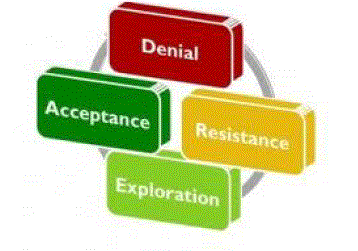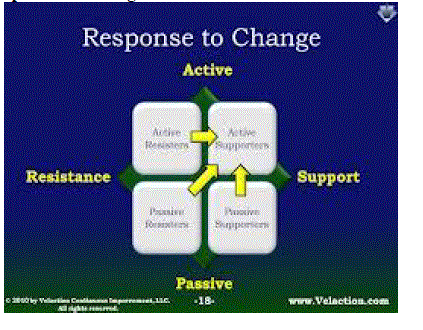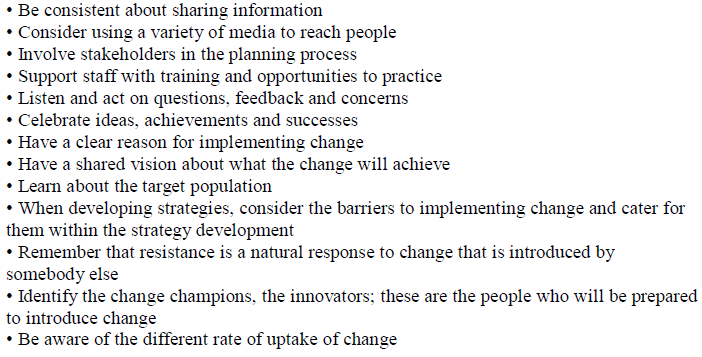ISSN ONLINE(2319-8753)PRINT(2347-6710)
ISSN ONLINE(2319-8753)PRINT(2347-6710)
|
R.Balaji Dept Of MBA, Bharath university ,Chennai – 73, India |
| Related article at Pubmed, Scholar Google |
Visit for more related articles at International Journal of Innovative Research in Science, Engineering and Technology
It occurs in every part of our personal and professional lives. Fueled by technology we see increased globalization, customization, political and regulatory reform, economic swings, information flow, customer/employee expectations, aspiring leaders and organizational transformation. Change management is first and foremost about people and their capacity to adapt to change. Since the HR department is all about recruiting, training and monitoring employee performance, it has a key role to play in any change management programme. There are different aspects in which HR can play a significant role . Organizations have varying abilities to respond to change. If an organization cannot change as fast as the pace of change in its environment, the chances of falling behind increases. The organizations are supposed to act like they built not to last but to change.
I.INTRODUCTION TO CHANGE INEVITABLE |
| The pace of change is rising exponentially. The HR department has to ensure that employees are motivated to undertake the change and participate in the change management programme. For this to happen they need to recruit the right people who can think out of the box and can bring a fresh perspective to the table. There are different kinds of change that an organization might undertake or be forced to undertake because of internal and external factors. The factors for change include reorganization and restructuring to meet the challenges of the future and also to act proactively to initiate chances of staying ahead in the competition. Changes are rapid, sudden and uncertain. This kind of change often disrupts organizational activities and forces them to reorient themselves accordingly. Changes can be organic which means that it evolves slowly and is like climbing gentle slope of a mountain. In this case Organization and the management have enough time to prepare for change and reorient themselves accordingly. Though inevitable Change is always resisted by many managers because the change initiators have not clearly spelt out the outcomes of the changes and the possible impacts that such changes have on the organization. The HR department has to ensure that employees are motivated to undertake the change and participate in the change management program. For this to happen, they need to recruit the right people who can think out of the box and can bring a fresh perspective to the table. |
II.CHANGE HAPPENS |
| Change happens everywhere. It occurs in every part of our personal and professional lives. Fueled by technology we see increased globalization, customization, political and regulatory reform, economic swings, information flow, customer/employee expectations, aspiring leaders and organizational transformation. Change management is first and foremost about people and their capacity to adapt to change. Since the HR department is all about recruiting, training and monitoring employee performance, it has a key role to play in any change management programme. There are different aspects in which HR can play a significant role . Organizations have varying abilities to respond to change. If an organization cannot change as fast as the pace of change in its environment, the chances of falling behind increases. The organizations are supposed to act like they built not to last but to change. |
III.RESISTANCE TO CHANGE |
| Individuals and organizations have different abilities to respond to change. If an organization cannot change as fast as the pace of change in its environment, the chances of falling behind rise. Change is here is here to stay. You can't run away from it, you can't make it go away. You can't return to the good old days. You can't continue to do your job as you have always done it. You live in a work world with customers who are increasingly demanding. Technology is changing in every aspect of work. |
 |
| The adoption of innovations involves altering human behavior and the acceptance of change. There is a natural resistance to change for several reasons. |
People resist change: |
| When the reason for the change is unclear. Ambiguity--whether it is about costs, equipment, jobs--can trigger negative reactions among users. |
| When the proposed users have not been consulted about the change, and it is offered to them as an accomplished fact. People like to know what's going on, especially if their jobs may be affected. Informed workers tend to have higher levels of job satisfaction than uninformed workers. |
| When the change threatens to modify established patterns of working relationships between people. |
| When communication about the change--timetables, personnel, monies, etc.--has not been sufficient. |
| When the benefits and rewards for making the change are not seen as adequate for the trouble involved. |
| When the change threatens jobs, power or status in an organization. |
IV.RESPONSE TO CHANGE |
 |
| An unwilling user can always make an idea fail, no matter how good it is. So it all depends upon how a Change is responded by the employees and HR plays a very significant role in getting a change implemented effectively and get the result successfully. |
Decision makers will be more responsive to change: |
 |
| If the information presented coincides with their current values, beliefs, and attitudes |
| If they perceive that the change will benefit them more than it will cost them |
| If the innovation requires marginal rather than major changes in their views or lives |
| If they have a demonstrated need for the innovation |
| If the innovation is introduced gradually so that people can adjust to the resulting change |
V.CHANGE ARISES FROM BOTH EVOLUTION AND REVOLUTION |
| The adoption of new ideas and techniques does not occur naturally but results from hard work, trial and error. It is important to recognize this fact and to make an effort to develop information that is concise, readable and to the point and to make sure the information reaches people who can use it. A broad spectrum of skills is needed to lead to effective management of innovation and change. There is no magic formula for success--no such formulas exist. Multiple channels of communication should be used to promote the adoption of an innovation. Never expect one report, one presentation, one telephone call or one conference to accomplish everything. Successful programs need to be carefully conceived and carried out. Human contacts are critical ingredients, and need to be used along with good written and visual materials. These materials are useless without an understanding of the needs, limitations and problems of the user. |
| Change agents can bring innovation for the user by examining their preconceived notions about the way things should be done. Personnel have to be receptive to change themselves, they have to be able to evaluate new ideas objectively and see their users --not as they have been --but as they might be. |
95% CHANGES IN ORGANISATIONS FAIL WHY? |
| The major obstacles to implementing change in an enterprise are centered on people and corporate culture. Nearly 60 percent of the executives and project managers surveyed say changing mindsets and attitudes is the biggest challenge to implementing change in an enterprise, followed by corporate culture at 40 percent. These challenges were flagged as more important than shortage of resources, highlighting that these problems are seen as inherently more difficult to solve even if given sufficient resources. |
VI.SUCCESSFUL IMPLEMENTATION OF CHANGE |
Some guiding principles in planning a change include: |
| having a plan for the project implementation but being prepared to adapt this if the outcomes at different stages show this to be necessary • having Executive (or senior) support which is essential for the success of a project, but Recognizing that change will come from bottom up • setting objectives and congratulating the team when each objective is achieved, but Remembering that improvement is an ongoing process • recognizing that a plan for introducing change and monitoring the effects of the change is Important, but gaining commitment of people is vital in the success of a project. |
| Successful implementation of system change is essential in the provision of safe, quality care to consumers. Implementation of improvement projects and sustaining the resulting change can be a difficult process. It has been stated all too often that quality improvement projects fail on a regular basis. The individual or the teams introducing change have a challenging task. Change management is one component of a successful project; the need for project planning and the use of quality improvement tools are also critical. Change management process must include an effective communication strategy. All stakeholders must have opportunities to express their views and attitudes as part of the planning process. A lot of improvement is about changing mindsets. It is about having the tools, techniques and confidence to work with colleagues to try something that is different. It is about understanding the possibilities of thinking differently and aiming to make practical improvements for patients and staff. |
Have a defined communication strategy |
 |
VII.CONCLUSION |
| The key to implementing change and continuous improvement is the effective exchange of information between people and process, a combination of business and human dimensions towards a shared objective. |